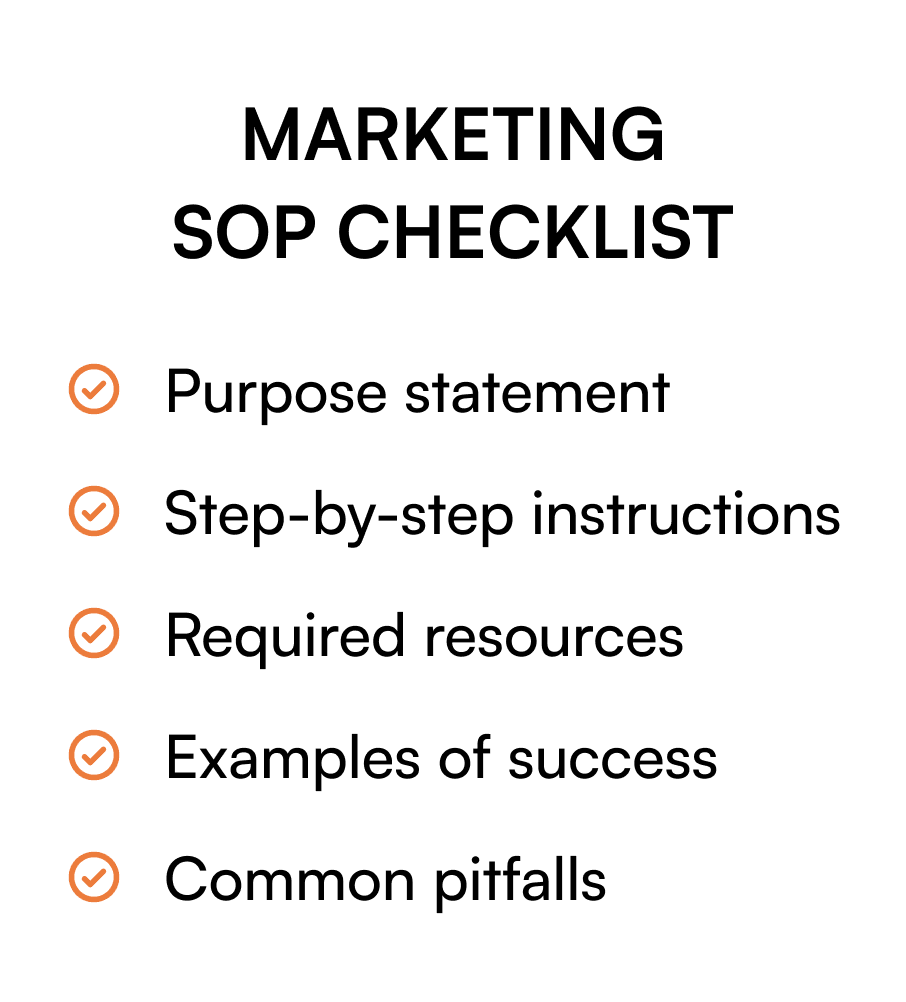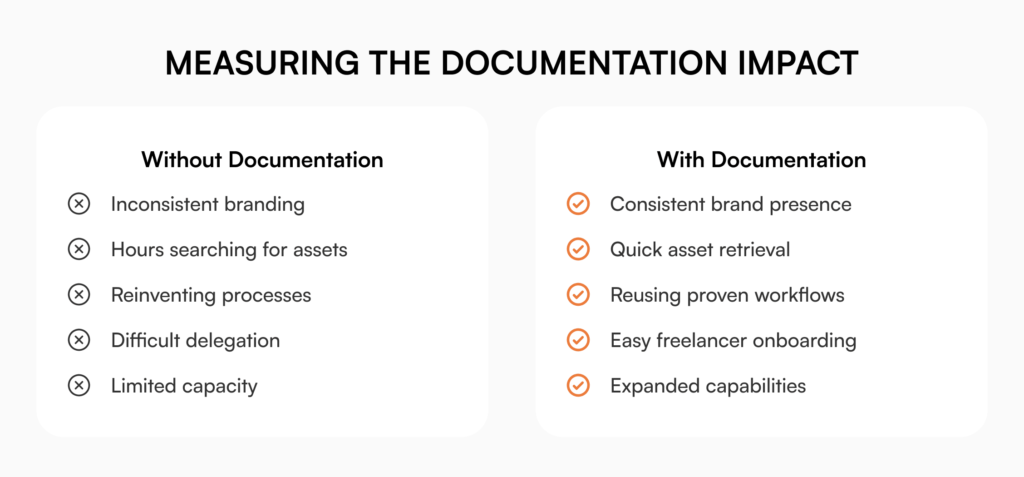Your marketing department of one doesn’t need to look or operate like one. Here’s how to leverage internal knowledge base systems to create the impact of a much larger team.
The reality of one-person marketing teams
Being a marketing department of one means wearing every hat in the marketing stack. You’re simultaneously the content writer, social media manager, email marketer, analytics specialist, designer, strategist, and campaign manager.
This juggling act creates a fundamental challenge: how do you maintain consistent quality across multiple channels when you’re constantly switching contexts? When you’re racing from creating social graphics to writing email copy to analyzing campaign performance, important details slip through the cracks. Brand inconsistencies emerge. Deadlines are missed. And stakeholders notice.
Consider this contextual scenario:
Your CEO wants to know why the latest email campaign used different messaging than the social campaign. The sales team is asking for updated product sheets that were supposed to be ready yesterday. Meanwhile, you’re trying to finalize next month’s content calendar while remembering exactly how you set up that successful campaign last quarter but the process lives only in your head.
This is where the strategic development of an internal knowledge base for marketing becomes not just helpful, but essential for survival. Without centralized marketing knowledge, you’re creating knowledge silos within your own role.
The power of marketing SOPs and templates
Standard operating procedures (SOPs) and marketing templates are the secret weapons of successful marketing departments of one. They transform your implicit knowledge into explicit systems that:
- Ensure consistency across all marketing activities
- Reduce the mental load of remembering every process detail
- Make it possible to delegate work without extensive training
- Create the impression of a larger, more organized team
According to research from CoSchedule, organized marketers are 397% more likely to report success than their disorganized counterparts. This organization isn’t about being naturally tidy; it’s about having systems.
Use this checklist to identify which marketing processes need SOPs first:
- Processes you perform at least twice monthly
- Tasks with multiple handoffs or approval stages
- Activities with brand compliance requirements
- Processes that frequently cause bottlenecks
- Tasks you would delegate first if you could
Marketing SOPs document the exact steps for completing recurring tasks like:
- Publishing blog posts (including SEO checklist, formatting guidelines, and promotion steps)
- Creating and scheduling social media content
- Setting up email campaigns
- Running monthly analytics reports
- Updating website content
- Managing content calendars
- Launching new campaigns
Templates complement these processes by providing standardized starting points for:
- Email designs and copy structures
- Social media posts for different platforms
- Blog post formats
- Press releases
- Product one-pagers
- Landing pages
- Campaign briefs
Establishing clear routines for recurring tasks frees up cognitive resources for more creative and strategic work. For small marketing teams, this means less time spent reinventing the wheel and more time for high-impact activities.
Building your marketing internal knowledge base
Creating a marketing internal knowledge base might sound like another task on your already overwhelming list, but it’s an investment that pays dividends immediately.
Following internal knowledge base best practices makes the process manageable and immediately valuable. Here’s how to approach it strategically:
Identify your highest-value processes
Start with marketing activities that:
- You perform frequently (at least monthly)
- Have multiple steps where mistakes commonly happen
- Would be difficult for someone else to take over without guidance
- Have significant consequences if done incorrectly
For most solo marketers, this includes your content publication process, campaign launch sequence, and reporting routines.
Read more: Building a Future-Proof Internal Knowledge Base
Document while doing
Instead of setting aside dedicated time to create documentation (which rarely happens), document processes while you’re actually performing them:
- Open a document or recording tool.
- Narrate what you’re doing as you complete the task.
- Note decision points and their rationale.
- Take screenshots of key steps.
- Clean up the documentation immediately afterward.
A well-structured marketing SOP should include these components:
- Purpose of the procedure
- Who performs it and when
- Step-by-step instructions (with screenshots where helpful)
- Links to necessary tools and resources
- Examples of successful completion
- Common pitfalls to avoid

Employees spend a considerable time waiting for information from colleagues. As a solo marketer, you’re waiting for information from yourself unless you’ve documented it in your internal knowledge base.
Create a logical organization system
Your internal knowledge base needs an intuitive structure. Consider organizing by:
- Marketing channel (Social, Email, Website, Events)
- Process type (Content Creation, Distribution, Analysis)
- Frequency (Daily, Weekly, Monthly, Quarterly)
Make sure your system includes:
- Clear naming conventions for all documents
- Version control to track updates
- Smart search functionality to find information quickly
- Easy access from anywhere you work
Making it look professional (without the extra headcount)
With your knowledge base foundation in place, you can leverage it to create the appearance and impact of a much larger marketing operation:
Maintain rigorous consistency
When everything from email signatures to social media graphics follows the same templates and style guidelines, your marketing looks coordinated and professional. McKinsey research shows that consistent customer journeys across channels increase customer satisfaction by 20% and lift revenue by up to 15%.
Create modular processes that scale
Break down marketing activities into distinct components that can be:
- Executed in parallel (by you or freelancers)
- Repurposed across multiple campaigns
- Scheduled in advance during low-demand periods
For example, divide content creation into research, drafting, designing, publishing, and promotion phases that can be batched together.
This decision path helps determine if a task should be batched, delegated, or automated:
- If task takes <10 minutes → Do immediately
- If task is creative → Batch similar creative tasks
- If task is repetitive → Create template or automate
- If task requires specialized skill → Consider delegation with SOP
Leverage your documentation with freelancers
When you do have budget for extra help, your knowledge base makes onboarding freelancers nearly effortless:
- Share the relevant SOP.
- Provide access to associated templates.
- Set clear deliverable expectations.
- Review work against your documented standards.
According to Upwork, nearly 50% of CEOs are planning to boost freelancer hiring in the coming year to fill skill gaps on their teams. Your documentation makes this integration seamless.
Automate the predictable
Identify repetitive tasks in your SOPs that could be automated:
- Email sequences
- Social media posting
- Performance reporting
- Content distribution
Automation platform Zapier reports that automation saves knowledge workers an average of 17.3 hours per week, that’s almost half the work week you can reclaim for strategic thinking.
Measuring the impact
How do you know if your documentation efforts are paying off? Look for these indicators:
Time savings
Track how long it takes to complete routine tasks before and after documentation. As a solo marketer, you can witness significant time savings on documented processes after the initial investment.
Error reduction
Monitor the frequency of mistakes or brand inconsistencies in your marketing outputs. Companies with standardized processes experience much fewer errors.
Stakeholder perception
Pay attention to how internal stakeholders talk about marketing. Comments like “I don’t know how you do it all” or “The marketing looks so professional” indicate your systems are creating the right impression.
Scaling capacity
Perhaps the most important metric: Are you able to take on additional marketing responsibilities without proportional increases in work hours? This indicates your systems are enabling leverage.

From solo operator to marketing powerhouse
Building a comprehensive internal knowledge base transforms you from a constantly reactive individual contributor to a strategic marketing leader with tools and systems that allow you to operate beyond your headcount.
This approach doesn’t just make you look bigger, it actually multiplies your capacity. When processes are documented, decisions are faster, quality is consistent, and your mental bandwidth is freed for the creative and strategic work that drives real marketing impact.
Start small by documenting your most frequent or problematic process today. Then systematically build your marketing knowledge infrastructure over time. The solo marketer that operates like a team of ten begins with a single SOP.
Key takeaways
- Start by documenting your most frequent and high-value marketing processes.
- Create templates for recurring content types to ensure consistency and save time.
- Organize your internal knowledge base logically with clear naming conventions.
- Use your documentation to efficiently onboard freelancers when you need extra help.
- Measure success through time savings, error reduction, and increased capacity.
How AllyMatter supports marketing teams of one
Solo marketers need an internal knowledge base that works as hard as they do. AllyMatter’s platform centralizes all your marketing SOPs, templates, and processes in one searchable repository that eliminates knowledge silos and enables true employee self-service.
Our intuitive organization system with smart search means finding your content calendar template or campaign checklist takes seconds, not minutes. With version control and granular access control, you maintain consistency while preserving the institutional knowledge that typically exists only in your head.
When you’re ready to bring in freelancers or scale your team, your marketing foundation is already documented and accessible.
Ready to transform your solo marketing operation with a purpose-built internal knowledge base? Join our waitlist to be among the first to experience AllyMatter’s marketing-focused features.
Frequently asked questions
Which marketing processes should solo teams document first?
Start with your content creation and publication process, as it typically involves multiple steps and touches various channels. Next, document your campaign launch sequence and reporting procedures. These three areas usually provide the highest return on your documentation investment.
How much time should I invest in creating marketing documentation?
Follow the 10/10/10 rule: If a task takes 10 minutes or more and you do it at least 10 times a year, spend up to 10 times the task duration documenting it. For a 30-minute task you perform monthly, investing up to 5 hours in creating a comprehensive SOP is worthwhile, you’ll recoup that time within a year.
What’s the difference between marketing templates and SOPs?
A template is a standardized starting document or format (like an email design or blog post structure), while an SOP documents the step-by-step process for completing a task (like publishing a blog post). Templates are often referenced within SOPs as resources to use during specific steps.
How do I keep my marketing knowledge base current as tactics evolve?
Schedule quarterly reviews of your most-used SOPs and templates. After major campaigns or projects, spend 15 minutes updating relevant documentation with lessons learned. Consider setting “expiration dates” on processes that may need frequent revision, and use version control to track changes over time.


